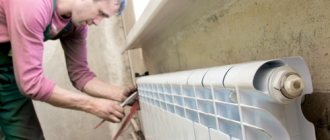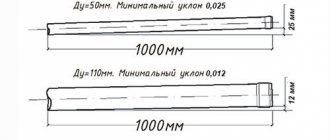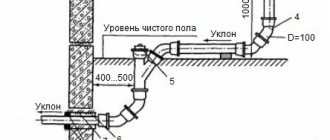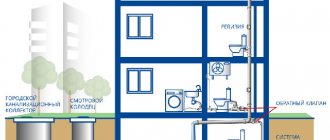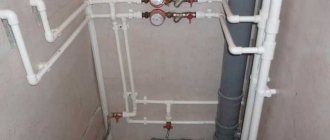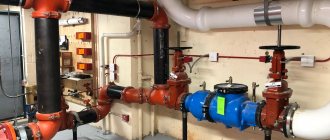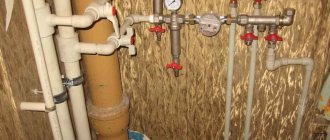A common problem is the smell of sewage in the toilet on the top floor. Apartment owners do not have special training and cannot determine the cause of the bad smell. Meanwhile, the penetration of sewer gases into residential premises poses a serious danger to people and requires immediate elimination.
To solve the problem, it is useful to have an idea of where this smell comes from. Let's consider the reasons for its appearance and ways to solve the issue.
Possible causes of odor
The first thing to remember is that the room smells like sewer gas. Its composition is complex, but the main component is hydrogen sulfide. This is a flammable and harmful gas that should not be allowed into the apartment. If the toilet, bathroom or kitchen smells like sewage, it means that somewhere there is a hole connecting the internal cavity of the system with the air in the apartment.
In order to figure out why there is a sewer smell on the top floor, we need to consider the possible reasons for the penetration of biogas into the apartment. More often. problem areas are:
- pipe connections. Leaks, cracks, and lack of quality sealing cause odor;
- lack of water seals on plumbing drain holes;
- problems with the drain pipe.
Poor-quality connections, as a rule, signal themselves by leaks. They can be seen on the pipe and the necessary measures can be taken. However, if the bathroom on the top floor smells like sewer, then the reason is most likely the lack of a water seal. You need to run the water for a few seconds and fill the siphon. If the smell disappears after a while, then the cause has been found.
The hardest part is troubleshooting. Arising with a sewer drain pipe. Let's take a closer look at this issue.
In-house system design
A common situation: there is a sewer smell in an apartment on the top floor, what should the owner do? First of all, understand the design of the in-house sewer system and determine the most problematic area. If the house is old (Khrushchev), then it has 5 floors. The system consists of a riser from which there are horizontal branches to each apartment. The sewer system on the top floor is different in that the riser goes into the drain pipe. It is led into the attic, then passes through the roof and ends at a height of at least 50 cm above the ridge of the roof. The vent pipe is an important element of the system, providing ventilation and regulating pressure.
When toilets are flushed in several apartments at the same time, water is released from bathtubs or other plumbing fixtures, a significant vacuum occurs in the riser. A normal vent pipe allows air to enter the cavity and equalize the pressure. If something is wrong with it, negative pressure draws water from the water seals, opening the passage for sewer gases into the apartment. Usually, the smell of sewerage on the 5th floor of a Khrushchev building indicates a malfunction in the drain pipe.
How not to do it
Sometimes the owner of an apartment on the top floor simply cuts off a piece of pipe that is unnecessary, in his opinion, and spoils the appearance of the bathroom. The upper end is tightly closed, stopping the flow of air into the system. After this, the water seals throughout the riser are under constant threat of failure.
Some service employees do this - they install a sewer valve at the upper end. Then, with a sharp drop in pressure, it opens and lets air into the system. The water seals remain intact, but the sewage system on the top floor causes gas to leak into the apartment. Since the valve is capable of opening not only at low, but also at high pressure, gas begins to flow into the home with any increase in volume.
Often in such constructions lies the answer to the question of why a new building smells like sewage. It would seem that the house is new, the pipes are still clean, the connections are sealed. Why does the apartment smell like sewage? The answer is simple - either errors in the design or during construction were rarely looked into the working documentation. A drain pipe is a must, especially in multi-storey buildings. Modern new buildings have at least 9 floors, so the vacuum or pressure surge can be quite strong. The valve may not provide sufficient air flow, causing water seals to break on several floors.
Also read: Connecting the installation to the sewer - how to connect a toilet
Purpose
A drain riser is a pipe that connects the sewerage system to the environment, i.e.
atmosphere. In practice, this looks like a continuation of the sewer riser, which is discharged through the attic to the roof. Therefore, the fan riser is also called a ventilation riser. But why does the sewer system need ventilation? Many beginners mistakenly believe that it only removes unpleasant odors from the sewer, but this is far from the case.
To answer the question posed, let's look at what processes occur in the sewer system when a large amount of waste flows through the riser.
In this case, the pipeline works like a pump, in which wastewater flowing in a large volume serves as a piston. Accordingly, as they move down in the sewer system, a zone of rarefied pressure appears above the drains. As a rule, this happens after flushing the toilet.
If the discharged pressure is not normalized by drawing in air through ventilation, air is sucked in through plumbing fixtures. As a result, the water seal breaks down in the area where it is weakest. Those. the water in the water seal is simply sucked into the system.
Let us remind you that a water seal is, in fact, a water valve that prevents the penetration of unpleasant odors from the sewer into the room. It is formed in a siphon, which must be installed between each plumbing fixture and the sewer.
Therefore, in the process of breaking the water seal, a characteristic “gurgling” sound is heard from the plumbing fixture, which is probably familiar to many apartment owners in multi-story buildings. After this, an unpleasant odor appears in the room, as gases from the pipeline begin to escape freely.
As you probably already guessed, a ventilation riser is precisely what is needed to equalize the pressure in the sewer system. According to current SNiP, it must be installed in all houses that have more than one floor.
Keep in mind that the lack of ventilation leads not only to the failure of water seals, but also to a deterioration in the permeability of the pipeline. This is especially noticeable in the “lying” section.
Accordingly, there can be no talk of any dismantling of the fan pipe, since this will only lead to a number of problems.
What to do
It is now clear where the smell of sewage in the apartment on the top floor comes from. What to do in such situations? The search for the source should begin with an inspection of the pipelines. It is necessary to examine all connections, inspect fittings, adapters and other components of the system. Try to determine where the smell comes from and at what points it intensifies. If the toilet and bathtub are separate, you need to find out where the sewer smell is stronger. Finding the source allows you to decide how to fix the problem.
The next step is to check the condition of the water seals. If they are torn off, it means that the fan pipe is not working. Problems of the opposite type are possible - gas bubbles through the water seal. This indicates high pressure in the system and the absence of free exit through the fan pipe. If a new building smells like sewage, most often the problem is the lack of ventilation in the system.
The reasons for the malfunction of the drain pipe may be:
- dismantling of the riser outlet by residents of the top floor apartment, carried out due to illiteracy;
- In cold weather, the drain pipe often freezes over, and ice or frost accumulates inside. They block the passage of gases, disrupting the operation of the system;
- Sometimes birds build nests in the pipe, blocking the exit to the outside.
In this case, fixing the problem on your own is not recommended. The sewer riser is a common property, and all work on it must be carried out by specialists from the management company. The apartment owner needs to contact the management company and describe the problem. Usually, such issues are resolved quickly and successfully.
How we connected two radiators to one riser on the top floor.
Read more about the specific installation of a battery with stainless steel piping on the top floor. Go ..
Let's consider a situation when the radiators on the top floor do not heat up and something needs to be done about it. However, by replacing the battery on the top floor, the situation cannot always be corrected, due to the fact that on some of the lower floors the batteries are connected incorrectly and because of this, the coolant stops flowing to the upper floors and heat may not reach the top floor at all.
This situation arises due to a misunderstanding of the difference between the principles of hydraulics and thermosiphon systems by those plumbers who perceive two adjacent risers as a two-pipe system and mistakenly connect the battery return to the return pipe - the riser, and the radiator supply to the supply riser, for example on the second floor of a five-story building.
As a result, a violation of the law of hydraulics occurs and all the apartments located above begin to have a catastrophic lack of heat, which goes from the supply riser to the return line directly through the battery of the smart guy who adopted the supply and return risers as a two-pipe system.
Attention! Only horizontal radiator branches can be considered two-pipe heating circuits! If we see two risers standing next to each other, then this is not a two-pipe system, but TWO RISERS!!! And many people stumble over this mistake.
On the Internet you can see these diagrams for connecting batteries.. Guess which one is correct?
They are both wrong! And now we will figure out why..
In the right figure in the so-called “single-pipe system” we see that the coolant moves from top to bottom - such a movement of the coolant is very rare in multi-story buildings, but has the right to life in thermosyphon heating systems, used mainly only in low-rise buildings or private houses with individual heating system. Where they first raise the flow of coolant to the very top, which subsequently cools and moves through the batteries, thereby ensuring its own circulation according to the principle of thermosiphon heating systems.
In the second picture we see a radiator connected to a “two-pipe system”, the word two-pipe system is in quotation marks... These idiots have two risers - supply and return, they can be called a two-pipe heating system! And now let’s figure out why, because of such idiocy, thousands of people on the upper floors suffer from a lack of heat in the radiators. The fact is that according to the law of hydraulics, as well as according to Ohm’s law, fluid through pipes selects areas with the least resistance, just like electricity moving through a conductor. So... if the IDIOT master closes these two pipes with a battery, then this battery will heat well! And all higher floors will instantly feel a drop in temperature in the batteries from 30% to 70%! And the higher the worse . Why is that? Because, according to the principle of hydraulics, the coolant has no motivation to move to higher floors due to the looping of two risers with a jumper in the form of a battery connected to two risers.
In hydraulic heating systems of multi-storey buildings, the coolant is supplied from below - through the basement line to the top WITHOUT JUMPERS! All batteries from the first to the last floor are hung on the supply riser. And only the last battery on the top floor can be used as a jumper for the heating circuit of the entire entrance. The return riser usually passes through a through transit riser, which, as previously written, is forbidden to be connected to the supply riser so as not to disrupt the hydraulics or, more simply put, not to shorten the hydraulic heating ring. This is not a two-pipe heating system, but a hydraulic circuit...!
At the same time, in hydraulics it makes absolutely no difference where the coolant is supplied from - the so-called supply from below or from above. In general, hydraulics does not take into account temperatures and the movement of the coolant in one direction or another as it cools. This is hydraulics that are pushed by powerful pumping stations, so the most important thing is not to shorten the hydraulic circuit by connecting batteries using the so-called two-pipe scheme as in the figure below.
A common reason why heat does not reach the upper floors. This is a shortening of the hydraulic circuit.
Now, after we have found out what could be the cause of a cold battery on the top floor, it is also worth recalling that a less likely cause of a cold battery on the top floor may also be airing of the last radiator in the riser. Therefore, it is recommended that owners of apartments on the top floors install automatic air vents on heating pipes and check that there are no air pockets in the radiators. Which can also be the reason for the heating battery not warming up.
The battery on the top floor is connected using an automatic air vent.
And finally, if you are absolutely sure that there are no air locks in your radiator on the top floor, then feel free to go down the riser to the neighbor who connected his radiator, naively believing that he is dealing with a two-pipe heating system. If you need advice from specialists who can distinguish risers with supply and return from a two-pipe heating system, please contact us - we will help all Nizhny Novgorod residents.
An original way of tying heating radiators on the top floor in a Khrushchev building
More details..
